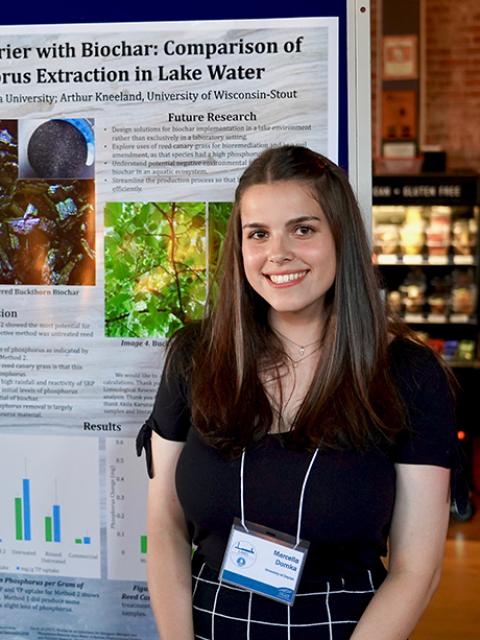
Marcella Domka
Environmental Biology major at University of Dayton
Faculty Mentor: Arthur Kneeland
Research Poster: Breaking Through the Pollution Barrier with Biochar: Comparison of Treatment Methods for Phosphorus Extraction in Lake Water
Marcella is from Cincinnati, OH and is a senior at the University of Dayton in Ohio. She is currently majoring in Environmental Biology. She immensely enjoyed the LAKES program and is grateful for the scientific experience it has given her. After graduating in the spring of 2020, she plans to further develop her passion for combating anthropogenic climate change by attending graduate school and earning a master’s degree. In the future, she looks forward to exploring sustainable initiatives through research that focuses on aquatic pollution and wildlife conservation. In her free time, Marcella enjoys hiking, playing tennis, watching The Office, and spending time with friends.
Breaking Through the Pollution Barrier with Biochar: Comparison of Treatment Methods for Phosphorus Extraction in Lake Water
This summer, my research team explored the potential for biochar to combat nutrient pollution in aquatic environments. Arthur, Madeline and I went through the process of biochar creation in a laboratory, and employed various chemical treatments in order to study which method most effectively extracted phosphorus from lake water samples. Biochar is a stable solid that is formed through pyrolysis, the burning of organic matter in the absence of oxygen. This results in a charcoal compound that can be treated with metallic compounds in order to extract aquatic pollutants such as nitrogen (N) and phosphorus (P). The extraction process occurs through chemical binding, in which positively charged metals used to treat the biochar attract the negatively charged phosphorus and nitrogen ions suspended in the lake water. Biochar has additional uses besides nutrient extraction. It can function as a carbon sink, plays a role in pollution remediation, and can be used a soil amendment to facilitate the growth of terrestrial plants.
Through the following chemical treatments, my research team and I were able to determine which methods showed the most potential for nutrient pollution reduction. Method 1 consisted of magnetite (Fe3O4), Method 2 consisted of iron (II) sulfate heptahydrate (FeSO4⋅7H2O), Method 3 consisted of commercial biochar (treated with magnesium and aluminum), and then we had a series of untreated biochar, and untreated biochar with a water rinse. We pyrolyzed two types of organic matter—buckthorn and reed canary grass. Both of these species are invasive in the Wisconsin area, indicating that biochar can be used to combat invasive species and prevent further ecosystem disruption. Our results showed that Method 2 for buckthorn was the most effective at removing phosphorus. We found that buckthorn Method 1 also showed a decrease in phosphorus, thought it was only a slight reduction and was not as consistently effective as buckthorn Method 2. Finally, we found that in the case of reed canary grass, all of the chemical treatment methods ended up adding phosphorus to the system. Though these findings were relatively unfortunate in terms of reed canary grass’s potential to be used in biochar, they did suggest that this species could be used for soil amendment, as terrestrial plants could rely heavily on the high amounts of phosphorus for growth. My team and I also performed calculations to determine the sheer amount of biochar that would be needed to fully combat the daily inflow of phosphorus. We calculated that approximately 40,000 pounds, or about 20 tons, of biochar would be needed to reduce the phosphorus pollution that is deposited on a daily basis. Overall, our experimental results indicate that the phosphorus extraction ability of biochar largely depends on the source material used and the chemical treatment method employed.
Reflecting back on this summer, I have come to truly appreciate how much I have learned and the different ways in which I have grown. Primarily, I was able to develop the scope of my scientific knowledge. I have familiarized myself with a variety of new laboratory techniques, such as SRP and TP analysis, centrifuge and UV spectrometer operation, chemical agent preparation, and biochar treatment with metallic compounds. I was also able to hone skills found outside a laboratory environment, including interviewing and public speaking, connecting with members of the Menomonie community, and branching outside of my comfort zone with activities such as tractor driving, canoeing, and some intense biking.
I have also noticed the ways in which I have changed as a person. First, I have become more confident in myself, both as a student and as a friend. I fostered good connections with my fellow researchers and mentors, and was able to better understand the qualities that I look for in others. Additionally, I was able to dive into things that make me content, such as spending time in nature, biking, and being with people who share similar passions to me. Finally, I am grateful that I was lucky enough to befriend nine incredibly smart, fun, and thoughtful women. I made some excellent friendships and experienced different schools of thought from students that were from all over the United States. I was glad to be the only one from my state that participated in this program, because I feel like this position helped me to focus on environmental issues that are not exclusive to my hometown.
This program has also enabled me to further myself career-wise. I have experienced two months of focused research, and produced a graduate-school level scientific poster. Researching critical environmental problems that have a significant effect on the Menomonie community has made me more aware of the scale of anthropogenic climate issues. I have also refined my scientific interests in terms of wanting to go into a research field, and have become more confident about going to graduate school. I would still like to learn more about the various fields I could go into, but I have heard positive things about obtaining a master’s degree. Overall, I had a fantastic summer and I am thrilled that I was chosen for this experience.
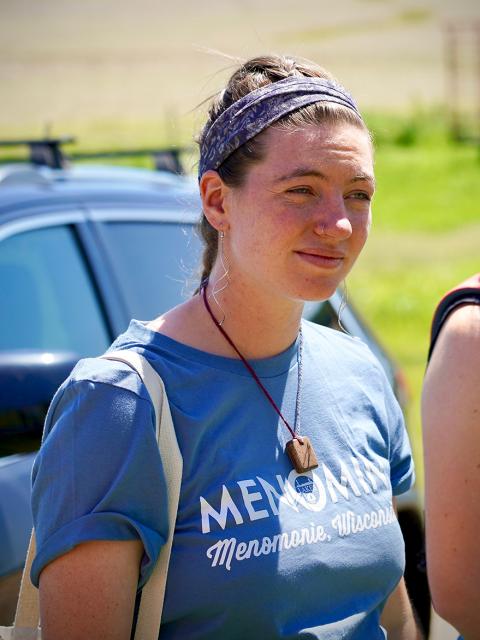
Nell Gehrke
Environmental Studies major at Augsburg University
Faculty Mentor: Kim Zagorski
Research Poster: Who Made the Lake Green? An Analysis of Public Perception
Nell Gehrke grew up running over the tops of hay bales and skipping rocks across rivers in southern Minnesota. She carried the love she had for her childhood pastimes into her undergraduate education. Nell is pursuing a major in Environmental Studies from Augsburg University in Minneapolis, Minnesota. After graduating, Nell hopes to spend a couple years canoe guiding before going to graduate school. Nell has big dreams of becoming a professor someday as an avenue through which to share her passion for the environment and community building.
Who Made the Lake Green? An Analysis of Public Perception
“Oh well you’re going to hate me because I’m a farmer,” is what my cousin Anna said after I told her I wanted to pursue an undergraduate degree in Environmental Studies. A few years have passed and, despite her warnings, I do not hate Anna. But since she said this, I’ve been interested in the relationship between farmers and non-farmers in the context of conservation and the environment.
This summer, Olivia and I explored the sentiments and perceptions of residents of Rice Lake and Dunn County in regards to the phosphorus pollution in the Red Cedar watershed. We conducted a mixed methods study where we used quantitative data from a public survey and qualitative data from 26 interview transcripts. We used these two methods to create a conversation between residents and policy makers, conservationists and farmers. A dialogue of commitment and connection to the health of the watershed was discovered.
Two thousand surveys were sent out to residents of Dunn County and Rice Lake up in Barron County. The different LAKES research groups worked on the survey collaboratively in order to gain more information about peoples’ relationship to the watershed, who they perceive as contributing to the phosphorus pollution, media markets people in the watershed turn to for information, where folks are shopping for groceries, and attitudes towards solar panels. Obviously, not all of these questions apply to the questions Olivia and I have. The two we focused on the most were, “To what extent do the following sources affect water quality in local lakes?” and “Which of the following groups do you think are open to changing their practices in order to improve water quality?” With these two questions we learned about public perceptions about who they think is responsible for the phosphorus pollution, and how the conversation can be carried beyond the initial blame.
We found folks in the watershed primarily attribute the phosphorus pollution to agriculture in the watershed. Causes such as damming of the river and natural phosphorus from the forests are also acknowledged by the public, but to a lesser extent. This is the reason why Anna said I would hate her because she’s a farmer. But, we wanted to take the conversation further than this. It turns out that the public also believes folks working in agriculture are open to changing their practices to address the water health. I carried the same sentiments when Anna and I had our conversation years ago. I knew she cared, and continues to care about the environment.
We continued to create the conversation around perceptions of pollution in the watershed through the interview transcripts. Four recurrent themes were discovered. We found people are acknowledging the economic and social pressures farmers are under. Agriculture does not live in a bubble. One person said, “I think there are economic pressures for commodity crop farmers to keep producing more … That means sometimes taking out field borders that are near streams, planting too close.” The second theme we found is the acknowledgement that farmers are independent folks. One interviewee said, “You know it’s easy to say the word farmer, but they’re all individuals and they all farm a little different piece of land.” Coupled with this theme was the third theme, blaming farmers creates ill will. Many interviewees mentioned blaming farmers does not help anyone and creates animosity between groups. Which leads to our fourth theme, solutions to the phosphorus pollution will require people to work together. “Everyone’s going to have to get together and pull their own line. The rural landowners, the cities, the municipal waste system, storm water plants, storm water groups, lake districts, government officials: state, county federal.” This final theme of collaborative problem solving marries well with the belief that farmers are willing to create changes in order to support conversation found in the quantitative data.
Over the summer we found the public believes farmers are the primary source of pollution, but that they are open to changing their practices. We also found that folks are acknowledging the economic and social pressures farmers are under. Our research suggests the conversation goes beyond just blaming farmers for turning the lake green. People in the community feel a strong connection to the watershed, and I believe this can be a sentiment on which to build a clean water movement.
I hope future research can continue this conversation and can engage the community in the dialogue around finding solutions to the algae blooms. Perhaps, future research can include finding ways for everyone to “pull their line.” After all, in Wisconsin, we’re all upstream from somebody. Research and action to remediate water quality at the community level can have a profound impact.
Anna and I just made plans to go kayaking through northern Iowa together. And you bet your bottom dollar, after a long day of paddling in the sun, we’ll enjoy some vegetables from her garden and some beef fresh from her farm.
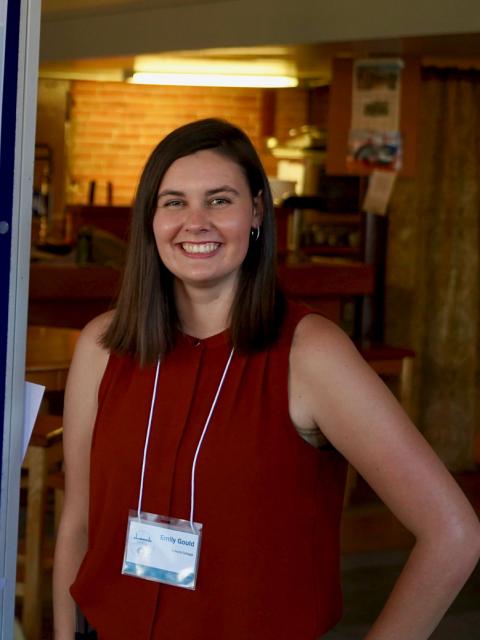
Emily Gould
Economics major at Eckerd College
Faculty Mentor: Zach Raff
Research Poster: Watershed Grants and Surface Water Quality: An Analysis of Clean Water Act Section 319
Emily Gould attends Eckerd College in St.Petersburg, FL. She is majoring in Environmental Studies and Economics. She plans on taking an economical approach in finding ways to improve and protect the environment. After graduating this year, she hopes to either join the Peace Corp or join the workforce before attending graduate school. When Emily he is not yelling at people for littering or running regressions, you can find her playing with her dog or exploring the outside world.
Watershed Grants and Surface Water Quality: An Analysis of Clean Water Act Section 319
Environmental policies are arguably one of the most important ways to combat environmental degradation. These policies provide necessary regulations, clean-up efforts, and funding to ensure the protection of our forests, oceans, lakes, and rivers. The Clean Water Act was implemented in 1972 and had been successful in remediating impaired water bodies across the United States. A significant accomplishment of the CWA is its ability to identify and prevent point source's from polluting water bodies. However, there was a lack of focus on combatting non-point source (NPS) pollutants from entering the watershed.
NPS pollution occurs when there are non-identifiable points of pollutants entry (i.e., runoff). This was addressed in 1987 when Section 319 was appended to the CWA. Section 319 allocates grants to watershed groups and aids in the implementation of best management practices (e.g., waste storage facilities, manure transfers) to combat NPS pollution from entering watersheds. One of the most prevalent forms of NPS pollution comes from agricultural runoff. Grants are allocated at a federal level and then distributed to watershed groups across the country. This program has been especially important in Wisconsin, where there are many surface water bodies have relatively high ambient concentrations of nutrients. Excess nutrients can cause toxic algal blooms and economic losses for local communities.
Our project looked at the relationship between Section 319 grants and total phosphorus (TP) levels in Wisconsin waterbodies. Right off the bat, we noticed that there was a trend between TP levels and allocated grants over time. We observed that TP tended to increase in the years that grant money had decreased. This led us to the hypothesis that 319 grants have been a crucial role in reducing nutrient runoff. To test our hypothesis, we utilized an economic analysis method, in which we could control other variables so that we could exclusively observe the relationship between TP and 319 grants.
Our analysis concluded that these grants have been successful in decreasing TP levels in water bodies. We gathered that with an average conditional grant of about $316,000, TP levels would fall by 21%. This concludes that the funding of best management practices through Section 319 has been effective in making water bodies less eutrophic.
It's evident that 319 grants have been able to combat NPS pollution; however, is it economically efficient? We decided to answer this question by conducting a benefit-cost analysis. We were able to find the "benefits" of this program by undertaking a benefit transfer. We obtained a willingness to pay value from a previous study. This study concluded that recreators would be willing to pay for 4.7 cents per 1mg/L of clean water. Under the assumption that households in Wisconsin would pay this same amount-- we took this estimated value and multiplied it by each household in Wisconsin. Although this is a conservative estimate, it was clear that the total recreational benefits of $39.4M outweighed the total cost of $15.3M in grants. From this, we can infer that this program is both economically viable and successful in decreasing nutrient runoff.
It is important to note that this project will not present immediate remediation results in impaired water bodies. The progress of this program is dependent on a continuous allocation of grants over time. Our results show that 319 grants are effective in preventing NPS pollution from entering watersheds, and therefore, the support for funding is necessary. Unfortunately, there has been a recent rollback of financing towards this policy. Our model proved that an increase in grants would lead to more significant improvements in water quality in TP. Consequently, a lack of funding would halt the progress of decreasing NPS pollution.
Section 319 of the CWA and similar policies must be supported. As previously stated, these policies cannot create change unless they are backed by continuous support and funding. As citizens of the United States, it is important to advocate and vote for legislation that will protect and improve our environment.
This summer was filled with laughter, new friendships, and exciting experiences. My research has only solidified my desire to continue working towards creating a sustainable future through the application of environmental economics. I am so thankful to have gotten the opportunity to work side by side with nine of the kindest, intelligent, and most inspiring women. I am also incredibly grateful to have gotten to the opportunity to work with my research partner Jacey, and our faculty mentor, Zach Raff. I am excited to apply my newfound knowledge and wisdom throughout my academic and professional career.

Ivy Huwald
Geography major at Humboldt State University
Faculty Mentor: Innisfree McKinnon
Research Poster: Stewards of the Land: Fostering Common Ground on a Changing Landscape
Ivy is beginning her final semester at Humboldt State University in Arcata, California. She is pursuing her degree in Geography and minoring in Ethnic Studies. She believes that environmental justice and social justice are deeply interwoven with one another. She’s passionate about critically engaging with urban and rural history including past, current, and future land management practices. After graduating, she plans to travel and work for a non-profit utilizing geographic analysis to address discrepancies and reimagine a more equitable future. In her free time she loves reading and writing, exploring the outdoors, and playing video games. Whether hiking in the redwoods or trekking the dangerous world of Skyrim, she’s always trying to learn a little something about the world that surrounds her.
Stewards of the Land: Fostering Common Ground on a Changing Landscape
View Research Project Here
There’s a recurring misconception that Lake Menomin has always been green, yet this is not the case. In fact the lake hasn’t always been a lake! The Red Cedar Watershed has a long history tied to various communities with different values. Dissecting the past offers us invaluable insight into the different ways that we have shaped the land and in turn, how the land has shaped us. By cultivating a general understanding of the implications of our past relationships to the Red Cedar Watershed, we become more informed and engaged with our current social and ecological communities that make our home, home.
This summer my partner Esther and I dedicated our summer to understanding these changes by asking: (1) How have interactions with the land evolved over time and what can we infer about our current and future land use patterns? And (2) How have our relationships to water changed and what forces acted to maintain or impede these changes?
Esther and I spent weeks digging through archival materials that included everything from travel brochures and postcards, to maps and oral histories. We analyzed all of this and took note of recurring themes. Each of these shed a unique light on the changing public and personal perceptions of the Red Cedar Watershed over the last several centuries. We were then able to condense these interactions into four primary epochs describing the driving forces behind interactions. These four consisted of: viewing the watershed as a source of livelihood; as an economic resource; as having recreational value; and most recently, as having an aesthetic/symbolic value to the community.
As early as 8000 BC the Ojibwe called much of northern Wisconsin, Minnesota, and Michigan home. Our research on pre-settlement land relationships focused on primarily the Ojibwe and their traditional relationships to the land as they depended upon it for sustenance. Wild rice was not only a staple part of their diet but also their culture. Wild rice fields once lined the shores of upper Midwest wetlands and were regularly managed by the native families who would return each year to harvest and to reseed. Controlled burning, hunting, and foraging were also commonly practiced.
Even today, the Ojibwe understand the land through Gakina-awiiya which means “We Are All Related”. This concept acknowledges that the environment should be treated with the same respect as a person, and therefore fosters more sustainable management practices and relationships to the land.
The next era was marked by an abrupt change in land use patterns and is a defining part of modern relationships to land. This era was defined by treating the land solely as an economic resource. With the influx of white settlement, the fur trade exploded while beaver populations plummeted. By the 1800s the fur trade had collapsed but the prospects of the timber industry encouraged settlement and extractive economies at a rate even greater than before. Yet again, destructive actions upon the land such as wetland removal, damming, and logging all had permanent effects on the environment despite the timber industry’s short-lived prosperity.
Moving into the 1900’s, we see that the environment maintains its economic significance through agricultural means but has developed recreational, symbolic, and aesthetic value. The town of Menomonie viewed the Red Cedar River and Lake Menomin as being deeply tied to its sense of community and sought to drive in tourism by promoting things like swimming, canoeing, and fishing. At the same time, the introduction of synthetic fertilizers, lawn mowing, and recreational parks become extremely popular and also have had long term effects on the land.
There’s no doubt that we’re at a turning point. As early as the 1970’s newspapers began mentioning green algae blooms affecting Lake Menomin. Relationships to the land are changing and our research shows that striving towards a reconciliatory landscape that acknowledges human’s role in the complex network of actors is vital as we move into the future.
It is important to acknowledge that there is no achievable “novel” landscape. However the more exploitative, extractive, and uneven our relationship to the watershed is, the more vulnerable it is to unsustainable interactions. Connection to the watershed is strongly associated with better land management practices, and should be cultivated through engaging with the community, participatory-based research, and integrative land management practices. As voters, community members, and stewards of the land we owe it to the watershed to acknowledge its inherent value, to stay informed and educated, and to acknowledge that we are not separate from, but part of the “natural” world.
Although the landscape has been physically and culturally altered by active and passive colonial, economic, and natural processes, it is necessary that we learn about and care for the land. Traditional and Local Ecological Knowledge of the environmental history of this place can inform current restoration practices. By working with the local community, which knows and values this place, scientists can make better conservation and restoration decisions.
This summer has instilled a new sense of passion and curiosity in me. Water quality, management, and access are without a doubt universal issues; the solutions certainly won’t be quick or easy, but they must strive to address social, environmental, and long term problems. Approaching the issues holistically and collaboratively, we can be sure that we’re taking regular vital steps to cultivating a more sustainable network of humans and the earth.
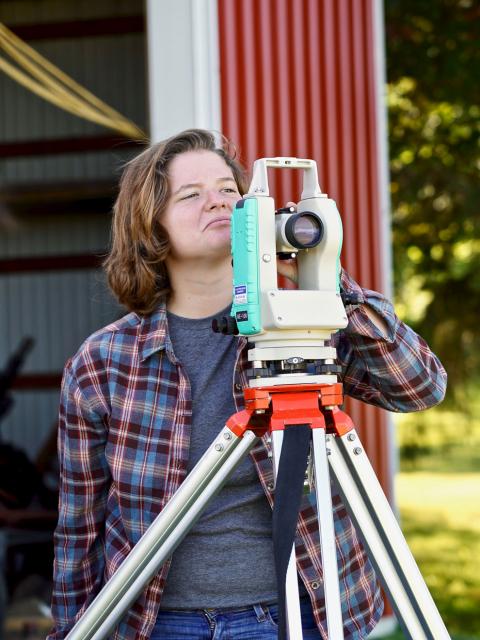
Esther Ramsay
Geography major at Macalester College
Faculty Mentor: Innisfree McKinnon
Research Poster: Planning as a Community: Mapping Soil Erosion with the Agricultural Conservation Planning Framework (ACPF)
Esther Ramsay is from Chicago and is going to be a senior at Macalester College. She studies geography, urban studies, and art. Esther plans to continue to address environmental issues in her future by working as an urban planner. She enjoys working and doing research from a geographical perspective and has a passion for making and critiquing maps. In her free time, Esther enjoys drawing, looking for delicious soup, and skipping rocks.
Planning as a Community: Mapping Soil Erosion with the Agricultural Conservation Planning Framework (ACPF)
View Research Project Here
This summer, my partner, Ivy Huwald, and I split our time between sitting in front of a computer running a GIS model known as the Agricultural Conservation Planning Framework (ACPF), and exploring the Red Cedar Watershed, talking to community members and farmers about the health of the water in the watershed. We used the ACPF to identify fields of high risk of runoff and locate possible locations for conservation practices in high risk fields to reduce runoff in Bronken and Hay Creek sub-watersheds.
We chose to run this analysis in these small sections of the watershed because they are heavily used for agriculture and because they are a part of a Farmer Led Council that is working on implementing more conservation practices in the area. Our hope is that the results of our research can be a useful tool for them if they are interested. We did this analysis on a small scale to ensure it was accurate and so we were able to really spend time getting to know these areas to ensure our model was reliable. The scale of this research also allowed us to get extremely accurate data and gave us a lot of time to check our results. The purpose of this summer project is to support and help the community with dealing with the phosphorus pollution in the lakes and rivers in the watershed.
We thought the ACPF would be a useful tool in this watershed because 45% of the land use in the watershed is agricultural. Agriculture is not the only source of phosphorus pollution, but it is a major contributor because it is so widespread. Fortunately, we know that there are specific conservation practices that can be used to reduce runoff from agriculture. It is a source of phosphorus pollution that is addressable and that can also have a large impact.
The ACPF provides a great opportunity for the community and farmers to decide where to devote resources and change practices to have the greatest impact on soil health and water quality. We also sent out 2,000 survey to residents in the watershed to gauge their connection to the watershed to see what kind of support and interest people had in cleaning up the watershed. We were pleased to see that 63% of the people who responded to the survey felt a strong connection to the watershed. This was exciting seeing as the ACPF relies on support and participation from the community and only works if people are interested in its results.
The results we got from the ACPF are a series of maps that show where runoff risk is located and where specific conservation practices would be most useful based on the topography, land use, and proximity of the field to water. We specifically looked at where grass waterways, nutrient removal wetlands, and contour buffer strips could be implemented. In the coming weeks, the goal is to take the ACPF results to Bronken and Hay Creek and get feedback from farmers on how useful and accurate this information is to them.
We learned that this analysis could be improved with more input along the way from people who know the landscape the best. Although we feel very confident and proud of our work we were limited by our knowledge of the landscape, and the next time we use a tool like this we hope to communicate and use more knowledge from the community to make it even more accurate.
There has been a lot of powerful and incredibly useful research that has come out of the LAKES REU program that has explained and discovered the issues with phosphorus pollution in the watershed and the meaning and value of the lake to the community. Our project has been a little different than some of our friends and past LAKES REU students because we weren’t answering a research question. Instead we were creating a planning tool for the community’s agricultural conservation practices. In many ways our project was special because we were able to take all that information and past research to inform our model and create a real life product that will hopefully be a useful tool in determining where conservation practices and resources will have the greatest impact on the health of the waterbodies.
This program has taught me a lot about how to conduct research and opened my mind. I learned a lot from the other nine brilliant women in this program who all had skills and passions in all different fields. I also learned a lot from the community. I have spent all my life in Chicago and coming to Menomonie I had no idea what to expect. My research taught me the importance of including the community in research, and living in Menomonie has taught me about a different lifestyle as I have really gotten to know the people, community, and the beauty of the state of Wisconsin.
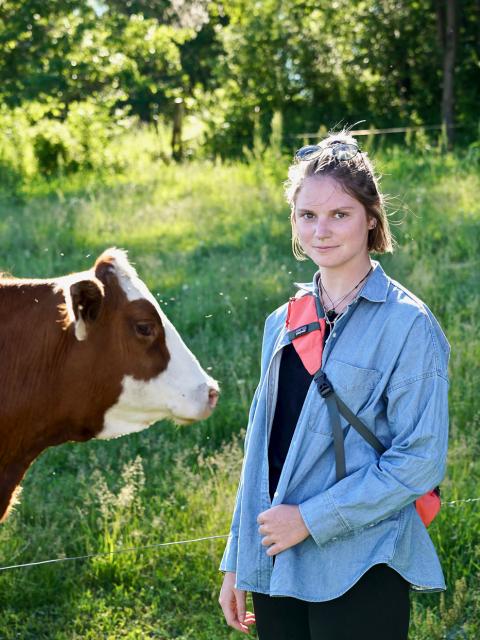
Olivia Regnier
Political Science major at University of Michigan
Faculty Mentor: Kim Zagorski
Research Poster: Hot Off the Press: Understanding Patterns in Media Consumption and Relationship to the Red Cedar Watershed
Olivia is a Michigan native and student at the University of Michigan. Her earliest memories include grass-stained pants and swims at her grandparents’ house. In December 2019, she will graduate with a quadruple major in Political Science; Environment; International Studies; and Russian, East, European, and Eurasian Studies. Olivia’s college career has been marked by immersive studies in the outdoors: in Wyoming, New Zealand, and now Menomonie. A passion for interdisciplinary work, community engagement, and wild spaces brought her to LAKES REU. Outside of academia, Olivia enjoys backpacking, rock climbing, and attempting to play the harmonica. After graduation, Olivia will head across the pond with a backpack and very few plans.
Hot Off the Press: Understanding Patterns in Media Consumption and Relationship to the Red Cedar Watershed
View Research Project Here
In the years that have followed the 2016 presidential election, I’ve found myself asking more questions about media than I ever had prior to that November. What is the role of media in the 21st century? What responsibility does the media have to its readers? Is the media allowed to take sides, or should all reporting remain objective? How should the media portray topics rooted in fact, but that have become politicized? In the era of social media, is traditional media becoming irrelevant? Do people trust the media? Do people really even care what the media has to say?
These questions, when asked about the American media industry as a whole, appear daunting to answer. However, when viewed in the context of a smaller community, such as the Red Cedar Watershed, they become more manageable.
During my time in the LAKES REU program, I sought to address a few of these queries in order to better inform future steps towards tackling the problem of phosphorus pollution in the watershed. Specifically, I asked: what media channels do residents of Dunn County and Rice Lake go to for information; how do patterns of media consumption correlate with perceptions of water quality in Dunn County and Rice Lake; and what is the role of the media in addressing scientific literacy in Dunn County and Rice Lake?
I began my research by investigating the relationship between science and media. I found that seventy one percent of Americans report they are at least somewhat interested in science news, according to a 2017 Pew Research Center Survey. This science news, it turns out, more often than not comes from a source that covers general news, such as a local news station, rather than from a source that specializes in science news.
To see how these national findings played out in the Red Cedar Watershed, I conducted a mixed methods study. I analyzed 26 interview transcripts for themes of scientific literacy, community knowledge sharing, and media usage. These interviews were conducted with journalists, farmers, policy actors, and government employees. I also conducted a local public opinion survey to further investigate findings from qualitative research. In June 2019, 2,000 surveys were equally and randomly distributed to residents of Dunn County and Rice Lake in Barron County via mail. The survey responses made up my quantitative findings.
My qualitative findings indicated a desire by public officials to educate citizens on scientific topics, perceived shift from local to national news markets, perception that environmental news stories will not attract readers, and an emphasis on social media as a potential for increased citizen engagement with science. Quantitative findings revealed that 80.4% of those surveyed consumed at least one form of local Wisconsin media and consuming Wisconsin media was positively correlated with using scientific data, posted warning signs, and news coverage as a way of determining whether local bodies of water were fit for recreational usage. Both survey results and interviews with local journalists indicate potential for social media as a way of sharing scientific knowledge. Twenty-two percent of those surveyed identified social media as the primary way that they stay up to date on community events and happenings compared to 42% who identified news coverage as the primary way they stay up to date.
From these findings, I have a few key takeaways. The first is that people in the Red Cedar Watershed are looking to local news sources for scientific information, indicating that they may be keener to read scientific articles than journalists perceive. Additionally, despite general downward trends in news consumption nationally, local media is still highly utilized by community members in Dunn and Barron County, Wisconsin. Lastly, social media and local news sources both hold many opportunities to share scientific knowledge within communities and should be greater utilized by all stakeholders.
The LAKES REU program focuses on issues of water quality and phosphorus pollution in West-Central Wisconsin. My research this summer, of course, will not magically fix these problems. What I think it will do, however, is better inform the way that we tackle these problems moving forward. Communication between community stakeholders is imperative if we hope to improve the state of our lakes and rivers, and I believe that by utilizing media outlets, we can build stronger channels of communication.
After all, if this experience has taught me anything, it's been about the power of communication and community building. The interdisciplinary nature of the LAKES REU program stresses the need to talk to folks with backgrounds different than your own. The research I conducted would not have been remotely possible without the support and collaboration of my amazing colleagues and mentors.
As for the questions that first got me thinking about media and its role in our everyday lives: I can’t say I have the answers to all of them. What I do know, however, is that acknowledging a problem and talking about it brings you a heck of a lot closer to solving it than if you simply pretend it doesn’t exist.

Elizabeth Saunders
Economics and Mathematics major at Indiana University
Faculty Mentor: Chris Ferguson
Research Poster: Cows, Corn, and Consolidation: Is More Farm Diversity a Good Thing?
Liz is from Westfield, Indiana and is currently pursuing a dual degree in math and economics at Indiana University. She enjoys how economics allows for a much more practical and interesting application of mathematical skills. In particular, she appreciates environmental economics and its importance to conservation. She plans to pursue a graduate degree in economics, hopefully focusing her research on a water-related issue. In her spare time, Liz enjoys working on puzzles, biking, rowing, and finding dogs to pet.
Cows, Corn, and Consolidation: Is More Farm Diversity a Good Thing?
Our research centered on the economic and environmental impacts of farm consolidation and crop diversity. I’ll admit, it sounds pretty dull. But I actually had a blast working on it this summer with my partner Lily and mentor Chris. Even in the moments when we were bored out of our minds downloading data tables (@ USDA please make your website better) and the moments when we all just wanted to smash our computers on the floor, I never lost interest in the overall goal. Maybe that’s just because Chris and Lily helped keep things interesting with their awesome selves. But I think it also had something to do with the fact that the questions we were asking were way more intricate and detailed than I had originally assumed they would be. For example: how do you measure crop diversity? By acres? By sales? By number of operations? We ended up just going with all of the above. But it’s the mini questions like that which ultimately held my interest and got me invested in the research.
There are also a lot of people interested in these questions, which is why we began studying it in the first place. For several decades now, Wisconsin farms have been falling in number and growing in size. When you look just at the average acres per farm it may not look like it’s been increasing, but that’s because it’s the distribution of small, medium, and large farms that’s been changing. Over time, there’s been a gradual shift away from medium-sized farms and towards extremely large and extremely small farms. This has been accompanied by a shift towards decreased crop and animal diversity as we see more enormous monocrop farms. So it only makes sense that people would want to know how this dramatic shift is affecting their local economies and environments.
We started our research by assembling data from 5 different Censuses of Agriculture dating between 1997 and 2017. After that, we created what’s known as a diversity index, which we then applied to each county in Wisconsin. A diversity index is essentially a formula that spits out one number that describes the overall diversity of a given county. After writing the codes for our indexes, all we had to do was input the numbers from the Ag Census, such as acres of maple syrup grown in Dunn County and number of operations growing pumpkins in Adams County. The formula then provided us with an easy way to compare the crop diversity of different counties.
To compare the farm consolidation of different counties, we calculated the percent of farms in a given county that are classified as large. For this, we just used the standard USDA definition of a large farm: any farm that grosses $500,000+ annually.
Using these numerical measures of diversity and consolidation, we analyzed their effects on counties’ Supplemental Nutrition Assistance Program (SNAP) enrollment and unemployment rate. Ultimately, what we found was that the having more large farms in a county was correlated with higher SNAP enrollment and a higher unemployment rate, so an overall worse economy. On the other hand, having more crop diversity was correlated with lower SNAP enrollment and a lower unemployment rate, so an overall better economy.
The exception to these general trends was dairy farms. We found that having more dairy cows per dairy farm was correlated with a very slight but still significant decrease in the unemployment rate. This seems to suggest that large crop farms are the farms driving the correlation between large operations and worse local economies.
Possibly the most shocking thing we found in our analysis was more directly related to water quality. We found that an increase of only 1% in the percentage of farms that are large is correlated with a 14% decrease in river quality. It’s one of those things that takes a second to fully take in. Which I know because so far eight or ten people have asked me to repeat that statistic at least three times.
It’s important to note that in our analysis we controlled for outside factors that influence an individual county’s SNAP enrollment, unemployment rate, and river quality. So, for example, if one county gains a Swiss Miss factory that provides jobs and helps lower unemployment, our analysis considers that and separates the effects of the Swiss Miss factory from the effects of farm consolidation and crop diversity.
Beyond just the research, the LAKES program was an amazing experience. We had a blast and learned a lot, and they’re not even bribing us to say that.
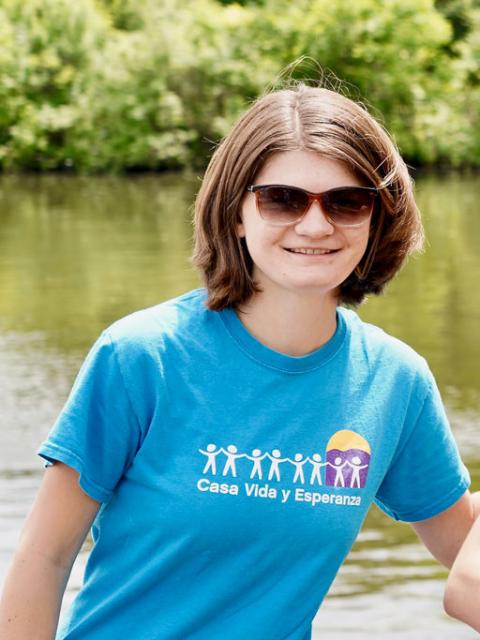
Jacey Schick
Environmental Economics and Policy major at University of Illinois at Urbana-Champaign
Faculty Mentor: Zach Raff
Research Poster: The Effects of the Conservation Reserve Program on Surface Water Quality
Jacey Schick is a senior studying Environmental Economics and Policy at the University of Illinois at Urbana-Champaign. Having grown up on a family grain farm in central Illinois, she is fascinated by the relationship between the environment and large-scale agriculture. After graduation, Jacey hopes to be involved in policy and public outreach to promote practices and policies that encourage a partnership between a healthy environment and productive large-scale agriculture. Outside of her studies, Jacey enjoys playing her clarinet, exploring new hiking trails, and reading a good book.
The Effects of the Conservation Reserve Program on Surface Water Quality
The water quality of Lake Menomin has been greatly affected by high nutrient levels. Algal blooms, caused by high total phosphorus levels, are toxic to the environment. Over the summer I worked with an amazing group of undergraduate students to gain a better understanding on the current local and state-wide water quality issues and to research methods of improving the water quality. My partner Emily and I focused our efforts on analyzing the effects of the Conservation Reserve Program (CRP) on total phosphorus levels in surface water in Wisconsin.
The CRP was enacted in 1985 to reduce nutrient levels in surface water and restore water quality. In this program, landowners retire environmentally sensitive farmland. This land is converted into vegetation that provides environmental benefits. The program has had varying impacts and goals throughout its almost 35-year existence but continues to be the largest federal, private-land retirement program that addresses environmental issues caused by agriculture. In our project, we sought to determine whether the CRP is effective at reducing total phosphorus levels in Wisconsin surface water bodies.
Throughout the summer, Emily and I used a data analysis program called STATA. This program proved to be useful in exploring and organizing data, creating graphs, and running regressions. The first step we took in becoming familiar with the data was exploring relationships among different variables. We used data from the EPA, USDA, USGS, and several other sources. Our sample period was between 1995 and 2017. We found that the number of acres enrolled in CRP in the Red Cedar Watershed was above Wisconsin’s average enrollment between 1995 and 2012. As the number of acres enrolled in CRP declined over our sample period, total phosphorus increased. We also found that the correlation between CRP acres and total phosphorus was positive. This relationship shows that the CRP is targeting areas of poor water quality.
Our results show that an increase in acres enrolled in CRP will lead to a decrease in total phosphorus levels in surface water bodies. Based on this program, when a HUC8 watershed enrolls 1000 acres in CRP, total phosphorus levels will decrease by 27.7% of the mean. The mean total phosphorus levels for all of Wisconsin during our sample period at the HUC8 level was 183 micrograms per liter. This estimate should be taken lightly because total phosphorus levels within a HUC8 vary.
We also performed a benefit-cost analysis to determine if the program has been economically efficient. During our sample period, the costs of the program were $848 million and the total recreational benefits were $1.66 billion. This analysis shows that the benefits outweigh the costs. It is important to note that this is a low estimate of the benefits. Taking into account other benefits, including health and housing markets, would potentially increase the benefits of the CRP.
Since the early 1990s, the government has been decreasing funding to the CRP and enrollment has been declining; however, as we demonstrated in our research, the program is effective at improving surface water quality. This trend shows that the government should reinvest money into the program. More landowners will be incentivized to retire their farmland which will lead to a reduction of total phosphorus in surface water.
Citizens should talk to their state legislators about the effectiveness of the CRP and the importance of supporting polices that aim to create a healthier environment. This program reduces total phosphorus levels in surface water bodies and is economically viable. Cleaning up the lake will take a long-term solution, but each action towards reducing total phosphorus levels in the surface water is one step closer to a cleaner, healthier lake.
This summer’s research has challenged me to think critically, be resourceful, and problem solve. I have enjoyed working with my partner Emily and faculty mentor Zach Raff. I am impressed with the research Emily and I have accomplished and how much I have learned. I feel more confident as a researcher in understanding the research process, and I feel more informed as college student in knowing how to apply the material I have learned in my studies to hands-on experiences.
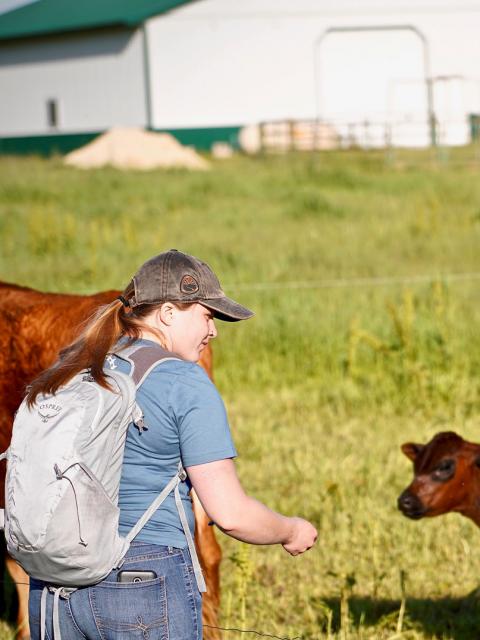
Lillian Strehlow
Economics major at University of Wisconsin-Eau Claire
Faculty Mentor: Chris Ferguson
Research Poster: Economic & Environmental Effects of Diversifying Agriculture with Photovoltaics
Economic & Environmental Effects of Diversifying Agriculture with Photovoltaics
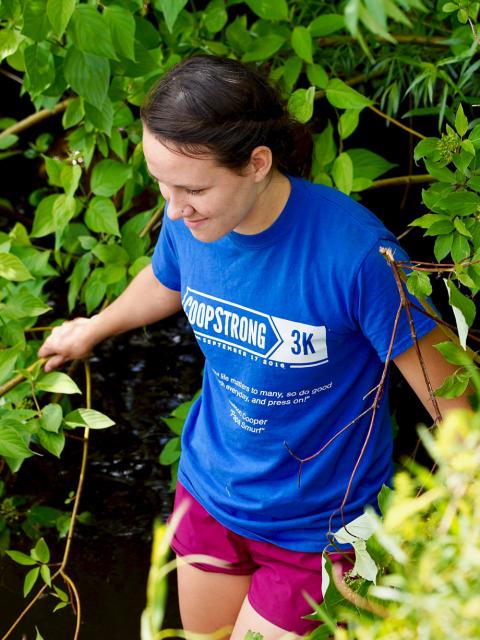
Madeline Tripp
Biology major at East Carolina University
Faculty Mentor: Arthur Kneeland
Research Project: Pollution into Potential: Exploring Ecological Methods of Phosphorus Mitigation




